INTRODUCTION
Caring for our pediatric patients is always a great pleasure. In my opinion, it is so great a pleasure that I have chosen to spend my entire career taking care of children. It is my passion! As dentists, we strive to provide complete patient experiences, seamless skills, and flawless results, all in the constant pursuit of perfection. We are not satisfied until we reach that excellence. While this is the same when we have children as patients, we are often pushed beyond the challenges of the tooth. Our concerns are the same as with adult patients: depth of decay, pulpal health, structural integrity of restorations, and all else that goes into excellent form and healthy function of the dentition. However, we are also presented with behavior management concerns. Young children have varying degrees of developmental stages according to their ages and, along with this, different and sometimes impulsive or unpredictable degrees of cooperation and tolerance for dental treatment. Given that, we must work even more efficiently and effectively when treating children. We must rely even more on excellent technique and outstanding materials. Any steps that will increase the chances of clinical success of a procedure on the first attempt should be taken.
The Most Common Restorative Material Being Used in Pediatric Dentistry
Although dental caries is a preventable disease, much of our time and resources in our offices are spent on dental restorations. The most common restorative material used in North America is composite resin. The NIH has estimated that more than 122 million composite resin restorations are placed in North American dental offices annually. In pediatric dentistry, a 2016 study assessed what types of direct restorative materials were used in posterior teeth by American and Canadian pediatric dentists. Results revealed that composite resin is the restorative material of choice for American and Canadian dentists when placing Class I, II, and V restorations in primary and permanent teeth in both healthy and medically compromised individuals.1 However, composite resin restorative material is highly technique sensitive, and care must be taken during placement. The material, as we know, is extremely hydrophobic and involves multiple steps for placement and accurate light curing. Although the longevity of composite resin restorations in primary dentition is higher than other tooth-colored intracoronal restorations (ie, glass ionomers) in a retrospective study of primary teeth, the annual failure rates for composites were found to be 9.5% for up to 4 years of followup.2 Another study showed a very wide variation in annual failure rate of composite resin restorations of between zero percent and 29.9%. This study showed that operator experience, size of the restoration, and the location or position of the tooth will affect the longevity of a restoration. A restoration that includes more than 3 surfaces is more susceptible to failure when restored with composite resin.3 The main reason for the failure of restorations is secondary caries. Secondary caries can commonly occur at margins of restorations and tooth structures and can be present for multiple reasons, including moisture contamination, incomplete light curing, voids of material, or and shrinkage of restorative materials. The ability to work in a moisture-controlled environment with reliable and efficient materials will certainly result in a higher success rate.4 Additionally, as new materials are developed, these results, and the annual failure rates and longevity of composite resin restorations in general, must be re-examined.5
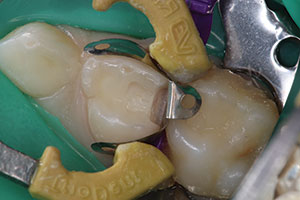 |
 |
| Figure 1. Preparation for the DO restoration in the primary tooth. The Triodent V3 Ring (Ultradent Products) was used here. | Figure 2. Selective-etch technique. |
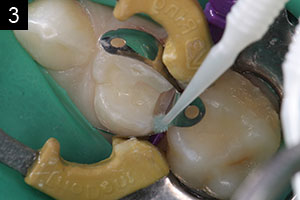 |
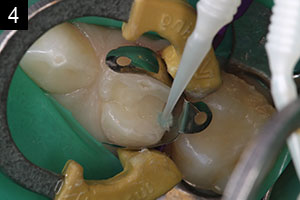 |
| Figures 3 and 4. Tokuyama Universal Bond (Tokuyama Dental America) was applied. No light curing is required for this adhesive. |
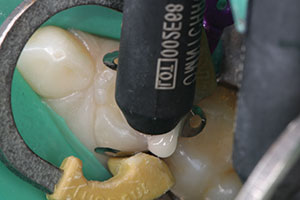 |
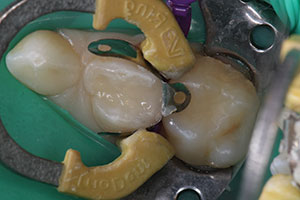 |
| Figure 5. Placement of the OMNICHROMA (Tokuyama Dental America) composite. | Figure 6. Shaped and light-cured composite resin restoration. |
 |
 |
| Figure 7. Postoperative photo of the completed composite resin restoration. | Figure 8. One-month follow-up photo. |
Increased Efficiency With Recently Introduced, Innovative Products
Tokuyama Dental America has introduced unique dental materials with efficiency and efficacy that allow for faster, more reliable treatments. Tokuyama Universal Bond (Tokuyama Dental America) is a unique self-cure universal adhesive with high bond strengths. It bonds to all dental substrates—for example, enamel, dentin, composites, zirconia, and metals. Placement involves only 3 simple steps: dispense and mix, apply, and air dry. There is no need to agitate, wait, or light cure before placement of the restorative material of choice. Eliminating the light-curing step shortens the procedure; eliminates errors from improper light-curing techniques, equipment, or operators; and also decreases the possibility of error in difficult-to-access areas, which curing lights may not be able to reach. The consequences of improper light curing are many, such as inflammatory response of the tooth; lower bond strengths; water sorption; microleakage; sensitivity; and, of course, recurrent decay.6 Tokuyama Universal Bond is compatible with all etching techniques: self-etch, total-etch, and selective-etch. Additionally, Tokuyama Universal Bond has a fluoride-release component. All of these features combined make it an excellent choice fo
r pediatric patients.
OMNICHROMA (Tokuyama Dental America) is a unique and cutting-edge resin composite material available as a single shade that literally blends seamlessly into the shade of the tooth being restored. “Omni-“ means “all” or “universally,” and “chroma” is “a quality of color combining hue and saturation” (Merriam-Webster Dictionary). So OMNICHROMA means “all colors,” as it is a single-shade resin composite that blends flawlessly and takes on the shade of surrounding tooth structure, whether it is anywhere from A1 to D4, making the restoration invisible. The uniform-sized, 260-nm, supra-nano, spherical SiO2-ZrO2 fillers produce the effect to create structural color to match the surrounding tooth structure. There is no need to shade match any longer, and even better, as a result, there is no longer any need to stock multiple shades in-office. OMNICHROMA is highly filled at 79% by weight, with low polymerization shrinkage and good radiopacity. It is BPA- and bis-GMA-free. Recently, concern over BPA and its derivatives’ estrogenic properties have led to the desire of some patients and dentists to not use materials that contain BPA. BPA can be found in a patient’s saliva up to 3 hours after placement of a composite resin restoration.7 With this composite, there are no BPA concerns. It can be placed in increments of 2 mm and light cured. There are many advantages to bulk filling whenever possible. Layering composite is, first and foremost, time-consuming. Incremental layers increase the likelihood of voids between increments and the chances of cohesive failure. Furthermore, incremental layering has been questioned and has not been shown conclusively to definitively help reduce the effects of shrinkage stress compared to bulk placement.8 Finally, this material polishes easily and effortlessly, making it a fast and easy composite resin material to place and finish. It is also appropriate for use in pediatric dentistry.
CASE REPORT
A 4-year-old patient presented with multiple caries. For the purpose of this case study, the focus will be upon the distal carious lesion (Tooth J). The quadrant is isolated using a ligated 2A Ivory rubber dam clamp and Hedy rubber dam. Preparation was done using a No. 556 cross-cut carbide bur, ensuring that adequate preparation would allow for a sufficient bulk of material. Cavity design and preparation should be as conservative as possible while, at the same time, allowing for sufficient depth of preparation to be able to have enough bulk of material at a suitable thickness for strength in order to resist the possibility of fracture. The strength of our restorative material, OMNICHROMA, in this case was excellent. Caution must be taken at the same time to ensure an adequate bulk of material to leave enough remaining tooth structure to maintain the integrity of the tooth. Attention must be paid so as to not undermine any cusps while removing any infected dentin. Care must also be taken to include mechanical retention into the preparation (Figure 1). As many children brux, mechanical retention is necessary since the occlusal portion of the tooth may be worn over time, and relying upon adhesive alone may lead to premature failure of the restoration.
The matrix system chosen for this case was the Triodent V3 Ring (Ultradent Products) and sectional matrices (Figure 1). The placement of sectional matrices is of utmost importance for the integrity of gingival margins. Interproximal contacts are certainly improved when sectional matrices are used. But in primary or mixed dentition, the contacts are less of a concern as the movement and position of teeth are much more fluid than in permanent dentition. Over a short period of time, loose contacts in primary dentition become tighter with the eruption of new teeth. Thus, the rationale for sectional matrix use in primary dentition is more for the adaptation of the matrix to the margins, allowing for less microleakage and greater longevity of the restoration. Anecdotally, I can attest that those composite restorations that I place using sectional matrices and rings most definitely have better longevity. Tokuyama Universal Bond is a self-etch adhesive. A selective-etch technique with 35% phosphoric acid was used in this case and is preferable whenever possible (Figure 2). It has been cited that a selective-etch technique of applying phosphoric acid etch to enamel by only using universal-type bonding agents enhances bond strength.9,10 Tokuyama Universal Bond is a 2-bottle self-cure system. One drop from each of the bottles Bond A and Bond B is mixed in a well and applied over all surfaces to be bonded. Care must be taken to ensure that bond is placed on all surfaces of both enamel and dentin, including those hard-to-reach areas: for example, the gingival box. In cases of primary dentition, a very small microbrush must be chosen in order to reach these areas (Figures 3 and 4). Once all surfaces are coated, a weak stream of air (5 seconds), followed by a medium stream of air (5 seconds), is directed at the tooth to evaporate the solvent. No light curing is required as Tokuyama Universal Bond is a self-cure adhesive. Direct restoration follows. In this case, OMNICHROMA was placed (Figure 5). Proper shaping of the composite prior to light curing minimizes any polishing required (Figure 6). The Triodent V3 Ring was removed, contacts were checked, and interproximal areas were cleaned with dental floss (Figure 7). The restoration was photographed at a routine followup at one-month postoperatively (Figure 8).
CLOSING COMMENTS
The placement of intracoronal composite restorations for children is one of the most common dental procedures in North American family practices. It is important to be able to place these restorations as effectively and efficiently as possible. We strive to provide the best for our patients. With advances in dental material technology, as found in Tokuyama Universal Bond and OMNICHROMA, we now have even more tools in our armamentarium to create and provide functional, aesthetic, and long-lasting restorations for our children.
References
- Varughese RE, Andrews P, Sigal MJ, et al. An assessment of direct restorative material use in posterior teeth by American and Canadian pediatric dentists: I. Material choice. Pediatr Dent. 2016;38:489-496.
- Dos Santos Pinto G, Oliviera LJ, Romano AR, et al. Longevity of posterior restorations in primary teeth: results from a paediatric dental clinic. J Dent. 2014;42:1248-1254.
- Bernardo M, Luis H, Martin MD, et al. Survival and reasons for failure of amalgam versus composite posterior restorations placed in a randomized clinical trial. J Am Dent Assoc. 2007;138:775-783.
- Chisini LA, Collares K, Cademartori MG, et al. Restorations in primary teeth: a systematic review on survival and reasons for failures. Int J Pediatr Dent. 2018;28:123-139.
- Antony K, Genser D, Hiebinger C, et al. Longevity of dental amalgam in comparison to composite materials. GMS Health Technol Assess. 2008;4:Doc12.
- Price RB, Rueggeberg FA, Labrie D, et al. Irradiance uniformity and distribution from dental light curing units. J Esthet Restor Dent. 2010;22:86-101.
- Fleisch AF, Sheffield PE, Chinn C, et al. Bisphenol A and related compounds in dental materials. Pediatrics. 2010;126:760-768.
- Pitel ML. Low-shrink composite resins: a review of their history, strategies for managing shrinkage, and clinical significance. Compend Contin Educ Dent. 2013;34:578-590.
- Rosa WL, Piva E, Silva AF. Bond strength of universal adhesives: a systematic review and meta-analysis. J Dent. 2015;43:765-776.
- Lenzi TL, Guglielmi Cde A, Umakoshi CB, et al. One-step self-etch adhesive bonding to pre-etched primary and permanent enamel. J Dent Child (Chic). 2013;80:57-61.
Dr. Cohn is a general dentist, devoted solely to the practice of dentistry for children. She maintains a private practice at Kids Dental in Winnipeg, Man, Canada. She is a proud member of the American Academy of Pediatric Dentistry Speakers Bureau, the Catapult Education Speakers Bureau, and the Pierre Fauchard Academy and is a cofounder of the Women’s Dental Network. Dr. Cohn has been named as one of Dentistry Today’s Leaders in Continuing Education for multiple years in a row. She has published several articles and webinars and enjoys lecturing both nationally and internationally on all aspects of children’s dentistry for the general practitioner. She can be reached via email at drcohn@shaw.ca.
Disclosure: Dr. Cohn receives financial educational support from Tokuyama Dental America.
Related Articles
Resin Infiltration Technique: Pediatric Applications
Pediatric Dentistry Should Focus on Caries Prevention
Posterior Composite Restorations: Increasing Predictability


